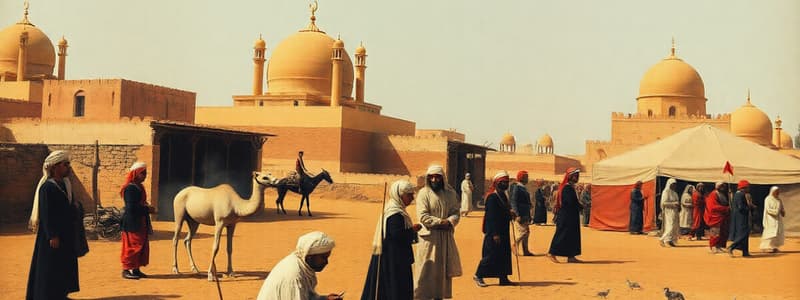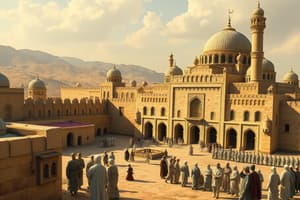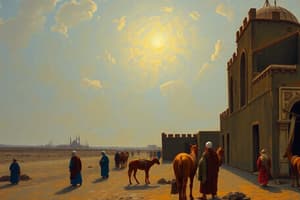Podcast
Questions and Answers
What was the primary function of the Majlis within Bedouin tribal structure?
What was the primary function of the Majlis within Bedouin tribal structure?
- To serve as religious scholars and interpret religious texts.
- To lead military expeditions.
- To nominate and advise tribal leaders (sheiks). (correct)
- To manage the economic trade and distribution of resources.
Which of the following best describes the significance of the Kaaba in pre-Islamic Mecca?
Which of the following best describes the significance of the Kaaba in pre-Islamic Mecca?
- It was a library that held the collective knowledge and history of the Arabian tribes.
- It was primarily a marketplace that boosted Mecca's economic status.
- It was a major religious monument that housed various polytheistic idols. (correct)
- It served as the primary meeting place for tribal leaders to discuss political matters.
Which of the following factors significantly contributed to the early success and spread of Islam?
Which of the following factors significantly contributed to the early success and spread of Islam?
- Economic incentives such as lower taxes (jizya) and religious tolerance. (correct)
- Suppression of trade and economic activity to focus on religious expansion.
- Strict social segregation and the establishment of a rigid caste system.
- Enforced conversion and destruction of other religious sites.
What was the primary reason for Muhammad's hijrah (self-imposed exile) to Medina?
What was the primary reason for Muhammad's hijrah (self-imposed exile) to Medina?
How did the 'Constitution of Medina' address religious diversity within the city?
How did the 'Constitution of Medina' address religious diversity within the city?
What is the primary difference between the Quran and the Hadith in Islamic tradition?
What is the primary difference between the Quran and the Hadith in Islamic tradition?
In Islamic history, what was the significance of the Battle of Karbala?
In Islamic history, what was the significance of the Battle of Karbala?
What was the core belief that distinguished Shia Muslims from Sunni Muslims regarding the selection of a caliph?
What was the core belief that distinguished Shia Muslims from Sunni Muslims regarding the selection of a caliph?
Which of the following best describes the role of Ibn Sina (Avicenna) in the context of Islamic intellectual history?
Which of the following best describes the role of Ibn Sina (Avicenna) in the context of Islamic intellectual history?
What was the outcome of the Battle of Tours?
What was the outcome of the Battle of Tours?
Which factor played the most significant role in the Spanish conquest of the Aztecs?
Which factor played the most significant role in the Spanish conquest of the Aztecs?
How did the belief surrounding Quetzalcoatl impact the interaction between the Aztecs and the Spanish?
How did the belief surrounding Quetzalcoatl impact the interaction between the Aztecs and the Spanish?
How did the Incan use of quipu contribute to their administration and governance?
How did the Incan use of quipu contribute to their administration and governance?
What was the primary objective of the Reconquista for the Spanish?
What was the primary objective of the Reconquista for the Spanish?
How did the agricultural technique of chinampas benefit the Aztec civilization?
How did the agricultural technique of chinampas benefit the Aztec civilization?
What was the role of the chasqui within the Incan empire?
What was the role of the chasqui within the Incan empire?
Which of the following best characterizes the Columbian Exchange's long-term impact on global populations?
Which of the following best characterizes the Columbian Exchange's long-term impact on global populations?
What was the main purpose of mitma in the Incan Empire?
What was the main purpose of mitma in the Incan Empire?
What motivated the Spanish conquistadors?
What motivated the Spanish conquistadors?
How did Marco Polo's travels contribute to European exploration?
How did Marco Polo's travels contribute to European exploration?
Which explorer's voyage is most associated with definitively proving the earth could be circumnavigated, even though the explorer died during the journey?
Which explorer's voyage is most associated with definitively proving the earth could be circumnavigated, even though the explorer died during the journey?
Which of the following best describes the long-term consequences of the transatlantic slave trade on African societies?
Which of the following best describes the long-term consequences of the transatlantic slave trade on African societies?
Which of the following was a primary goal of Alfonso de Albuquerque in establishing a Portuguese base in India?
Which of the following was a primary goal of Alfonso de Albuquerque in establishing a Portuguese base in India?
Which of the following describes the primary purpose of the encomienda system implemented by the Spanish in the New World?
Which of the following describes the primary purpose of the encomienda system implemented by the Spanish in the New World?
How did the marriage of Ferdinand and Isabella impact the future of Spain?
How did the marriage of Ferdinand and Isabella impact the future of Spain?
How did the Dutch use New Amsterdam's location to their advantage?
How did the Dutch use New Amsterdam's location to their advantage?
Which of the following explorers is credited with realizing that Columbus had discovered a new continent, leading to the naming of America?
Which of the following explorers is credited with realizing that Columbus had discovered a new continent, leading to the naming of America?
What was the primary significance of Lake Texcoco for the Aztec civilization?
What was the primary significance of Lake Texcoco for the Aztec civilization?
What was the purpose of the repartimiento system implemented by the Spanish in the Americas, and how was it often exploited?
What was the purpose of the repartimiento system implemented by the Spanish in the Americas, and how was it often exploited?
How did the Treaty of Tordesillas, proposed by Pope Alexander VI, aim to resolve territorial disputes between Spain and Portugal, and what were its long-term consequences?
How did the Treaty of Tordesillas, proposed by Pope Alexander VI, aim to resolve territorial disputes between Spain and Portugal, and what were its long-term consequences?
Flashcards
Bedouin Tribes
Bedouin Tribes
Nomadic tribes in the Arabian Peninsula who traveled via caravan routes.
Sheiks
Sheiks
Tribal leaders who govern Bedouin tribes.
Majlis
Majlis
Council of Bedouin tribes that nominates sheiks.
Mecca
Mecca
Signup and view all the flashcards
Kaaba
Kaaba
Signup and view all the flashcards
Hijrah
Hijrah
Signup and view all the flashcards
Umma
Umma
Signup and view all the flashcards
Caliph
Caliph
Signup and view all the flashcards
5 Pillars of Islam
5 Pillars of Islam
Signup and view all the flashcards
Shia vs. Sunni Muslims
Shia vs. Sunni Muslims
Signup and view all the flashcards
Huitzilopochtli
Huitzilopochtli
Signup and view all the flashcards
Prince Henry the Navigator
Prince Henry the Navigator
Signup and view all the flashcards
Bartolomeu Dias
Bartolomeu Dias
Signup and view all the flashcards
Tenochtitlan
Tenochtitlan
Signup and view all the flashcards
Chinampas
Chinampas
Signup and view all the flashcards
Vasco da Gama
Vasco da Gama
Signup and view all the flashcards
Alfonso de Albuquerque
Alfonso de Albuquerque
Signup and view all the flashcards
Quetzalcoatl
Quetzalcoatl
Signup and view all the flashcards
Tlaloc
Tlaloc
Signup and view all the flashcards
Pedro Cabral
Pedro Cabral
Signup and view all the flashcards
Hernan Cortes
Hernan Cortes
Signup and view all the flashcards
Christopher Columbus
Christopher Columbus
Signup and view all the flashcards
Columbian Exchange
Columbian Exchange
Signup and view all the flashcards
Amerigo Vespucci
Amerigo Vespucci
Signup and view all the flashcards
Ferdinand Magellan
Ferdinand Magellan
Signup and view all the flashcards
Mitma
Mitma
Signup and view all the flashcards
Atahualpa
Atahualpa
Signup and view all the flashcards
Middle Passage
Middle Passage
Signup and view all the flashcards
Reconquista
Reconquista
Signup and view all the flashcards
Encomienda System
Encomienda System
Signup and view all the flashcards
Study Notes
Bedouin Tribes
- Nomadic tribes that lived across the Arabian peninsula.
- Used caravan routes.
- Pre-Islamic Arabia.
Sheiks
- Tribal leaders that ruled over Bedouin tribes.
Majlis
- Bedouin tribal councils.
- Nominated sheiks.
Mecca
- Wealthy trading center in the Arabian Peninsula.
- Holiest Arabian city.
- Early Mecca was a polytheistic religious center.
Kaaba
- Major religious monument in Islam.
- Holiest spot in Islam.
- House of God.
Muhammad
- Born into the Quraysh tribe.
- Raised by his uncle, Abu Talib.
- Islamic prophet.
Khadija
- Wife of Muhammad.
- Wealthy widow and businesswoman.
Cave of Hira
- Where Muhammad first received revelations from the angel Gabriel.
Islam
- Submission to God.
Quran
- Islamic holy text.
Hadith
- Islamic rule book.
- Word of the man.
5 Pillars
- Faith, prayer, fasting, charity, pilgrimage.
- Islamic principles.
Hijrah
- Self-imposed exile.
- Predominantly Jewish city, Muhammad sought refuge in Medina.
- Medina became the political capital for Muhammad.
Umma
- Islamic community.
Quba
- First mosque built in Medina.
- Originally a religious center for all religions.
Constitution of Medina
- First Islamic constitution.
- Brought people together.
- Religious toleration in the city.
Caliph
- Supreme political and religious leader in a Muslim government.
- Successor of the message of God.
- Abu Bakr was the first caliph.
Caliphate
- Land a caliph rules over.
Jihad
- Holy war / holy struggle.
Jizya
- Lower taxes.
Why Islam Succeeded
- Lower taxes, religious toleration, economic benefits, rejected slavery.
- Fitna: Religious civil war among Muslims.
- Hussein: Muhammad's grandson.
- Battle of Karbala.
Shia Muslims
- Belief that the caliph should be a direct blood connection to Muhammad.
Sunni Muslims
- Belief that the caliph should be the best qualified person.
Ashura
- Muslim holiday.
- Belief that Moses parted the red seas, Noah got off the Ark, Muhammad reached Medina, and Hussein died at Karbala.
- Battle of Tours.
Caliph, Patron of Learning
- Patron of learning.
Ibn Sina
- Created canon of medicine, advanced medicine.
Sultan
- Holder of power.
Battle of Manzikert
- Turks control of middle east until WWI.
- Taking of Anatolia.
Azatlan
- Legendary ancestral home of the Aztec peoples.
Huitzilopochtli
- Protector god of the Aztecs.
Tenochtitlan
- Aztec capital, modern-day Mexico City.
- On Lake Texcoco.
- Population 80,000-250,000.
Chinampas
- Floating farming islands made by the Aztecs.
Quetzalcoatl
- Aztec nature god, feathered serpent.
- His disappearance and promised return coincided with the arrival of Cortes.
Tonatiuh
- Sun god of the Aztecs.
Tlaloc
- Rain god.
Shaman
- Ancient doctors, spiritual healers.
Nahuatl
- Aztec language.
Hernan Cortes
- Spanish explorer and conquistador.
- Led the conquest of Aztec Mexico (1519-1521).
Montezuma
- Powerful Aztec monarch who fell to the Spanish conquerors.
- Reasons why the Spanish were able to defeat the Aztecs:
- Belief that the Spanish were gods.
- Disease.
- Superior weapons (guns).
- Use of animals (dogs of war).
- Aided by Aztec enemies.
Columbian Exchange
- Exchange of plants, animals, diseases, and technologies between the Americas and the rest of the world.
Why it was more deadly to the natives:
- Fast killer diseases.
- Animals carrying diseases.
- No immunity developed.
Mitma
- Forced migration.
Tahuantinsuyo
- Land of four quarters, Inca Empire.
Cuzco
- Capital of the Inca.
Chasqui
- Inca runner and message carrier.
Quechua
- Inca oral language.
Quipu
- Arrangement of knotted strings on a cord to record numerical information.
Machu Picchu
- High city, "city in the sky," Inca.
Francisco Pizarro
- Spanish explorer who conquered the Incas.
- Founded the city of Lima (1475-1541).
Atahualpa
- Last ruling Inca emperor.
- Executed by the Spanish.
Battle of Cajamarca
- Battle between the Spanish and the Incas.
- Atahualpa (Inca ruler) was captured and killed by Pizarro and the Spaniards.
Marco Polo
- First European to travel the length of Asia.
Portolani
- Charts, maps of the known world.
Motives of the Spanish
- God, gold, and glory.
Reconquista
- Christian leaders drove Muslims and Jews from Spain (1100s-1492).
Prince Henry the Navigator
- Prince of Portugal.
- Explored West Africa.
Bartolomeu Dias
- Attempted to sail around the southern tip of Africa.
Vasco da Gama
- First European to sail to India.
Alfonso de Albuquerque
- Portuguese explorer who established a base in India.
- Gained control of the spice trade.
Goa
- Indian headquarters.
Pedro Cabral
- Claimed Brazil for Portugal.
Ferdinand and Isabella
- Marriage that unified Spain.
Christopher Columbus
- Modern-day Cuba.
Amerigo Vespucci
- Realized Columbus discovered a new continent.
- America was named after him.
- (1451-1512)
Waldseemüller map
- Warped depiction of the world by a German cartographer in 1507.
Vasco Núñez de Balboa
- Spanish explorer who explored Panama (crossed the Isthmus of Panama).
- Saw the Pacific Ocean.
Ferdinand Magellan
- Spanish explorer.
- Circumnavigated the world.
- Claimed the Philippines for Spain.
Philippines
- Claimed by Magellan for Spain.
El Cano
- Finished Magellan's circumnavigation of the world.
Viceroys
- Vice kings.
New Spain
- California to Panama, Mexico City.
Peru
- Panama through South America, Cuzco.
Encomienda
- Slavery of Indigenous people.
- Forced transfer of religion.
- Bartolome de las Casas.
Repartimiento System
- Required tax for citizenship.
- Forced labor if unable to pay taxes.
2 weeks of average work
- Average length of work.
Pope Alexander VI
- Divided the world into two hemispheres through the Treaty of Tordesillas.
Netherlands
- Dutch East India Company established trading posts in the Caribbean and Brazil.
- New Amsterdam.
Lake Texcoco
- Important for fishing, agriculture, and defense strategy.
- Surrounded by water and mountains.
Triangular Trade
- Three-way system of trade between Africa, Europe, and the New World.
Middle Passage
- Second stage of triangular trade.
- Slaves journey to the New World.
- Horrible conditions.
- High death rate.
Long-Term Effects of the Slave Trade
- Depletion of entire areas.
- Deconstruction of local African economy.
- Middle class (depopulation).
Abu Kabir
- First caliph, close friend of Muhammad.
- Married one of Muhammad's daughters (Fatima).
Studying That Suits You
Use AI to generate personalized quizzes and flashcards to suit your learning preferences.




